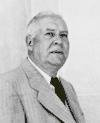- Stevens, Wallace
-
born Oct. 2, 1879, Reading, Pa., U.S.died Aug. 2, 1955, Hartford, Conn.U.S. poet.Stevens practiced law in New York City before joining an insurance firm in Hartford in 1916; he rose to vice president, a position he held until his death. His poems began appearing in literary magazines in 1914. In Harmonium (1923), his first and most verbally brilliant book, he introduced the theme that occupied his creative lifetime and unified his thought: the relationship between imagination and reality. His later poetry, in collections such as Ideas of Order (1936), The Man with the Blue Guitar (1937), and The Auroras of Autumn (1950), continued to explore this theme with greater depth and rigour. Not until his late years was he widely read or recognized as a major poet by more than a few; he received a Pulitzer Prize only with his Collected Poems in 1955. He is now often considered one of America's greatest 20th-century poets.
 Wallace Stevens, 1952.© Rollie McKenna
Wallace Stevens, 1952.© Rollie McKenna* * *
▪ American poetborn Oct. 2, 1879, Reading, Pa., U.S.died Aug. 2, 1955, Hartford, Conn.American poet whose work explores the interaction of reality and what man can make of reality in his mind. It was not until late in life that Stevens was read at all widely or recognized as a major poet by more than a few.Stevens attended Harvard for three years, worked briefly for the New York Herald Tribune, and then won a degree (1904) at the New York Law School and practiced law in New York City. His first published poems, aside from college verse, appeared in 1914 in Poetry, and thereafter he was a frequent contributor to the literary magazines. In 1916 he joined an insurance firm in Hartford, Conn., rising in 1934 to vice president, a position he held until his death.Harmonium (1923), his first book, sold fewer than 100 copies but received some favourable critical notices; it was reissued in 1931 and in 1947. In it he introduced the imagination–reality theme that occupied his creative lifetime, making his work so unified that he considered three decades later calling his collected poems “The Whole of Harmonium.”He displayed his most dazzling verbal brilliance in his first book; he later tended to relinquish surface lustre for philosophical rigour. In Harmonium appeared such poems as “Le Monocle de Mon Oncle,” “Sunday Morning,” “Peter Quince at the Clavier,” and Stevens' own favourites, “Domination of Black” and “The Emperor of Ice-Cream”; all were frequently republished in anthologies. Harmonium also contained “Sea Surface Full of Clouds,” in which waves are described in terms of such unlikely equivalents as umbrellas, French phrases, and varieties of chocolate, and “The Comedian as the Letter C,” in which he examines the relation of the poet, or man of imagination, to society.In the 1930s and early '40s, this theme was to reappear, although not to the exclusion of others, in Stevens' Ideas of Order (1935), The Man with the Blue Guitar (1937), and Parts of a World (1942). Transport to Summer (1947) incorporated two long sequences that had appeared earlier: “Notes Towards a Supreme Fiction” and “Esthétique du Mal” (“Aesthetic of Evil”), in which he argues that beauty is inextricably linked with evil. The Auroras of Autumn (1950) was followed by his Collected Poems (1954), which earned him the Pulitzer Prize for Poetry. A volume of critical essays, The Necessary Angel, appeared in 1951.After Stevens' death, Samuel French Morse edited Opus Posthumous (1957), including poems, plays, and prose omitted from the earlier collection.Additional ReadingRobert Buttel, Wallace Stevens: The Making of Harmonium (1967), includes some of Stevens' juvenilia. A work by the poet's daughter, Holly Stevens, Souvenirs and Prophecies: The Young Wallace Stevens (1977), includes the complete juvenilia and journals. A late critical commentary is provided by Harold Bloom, Wallace Stevens: The Poems of Our Climate (1977).* * *
Universalium. 2010.
